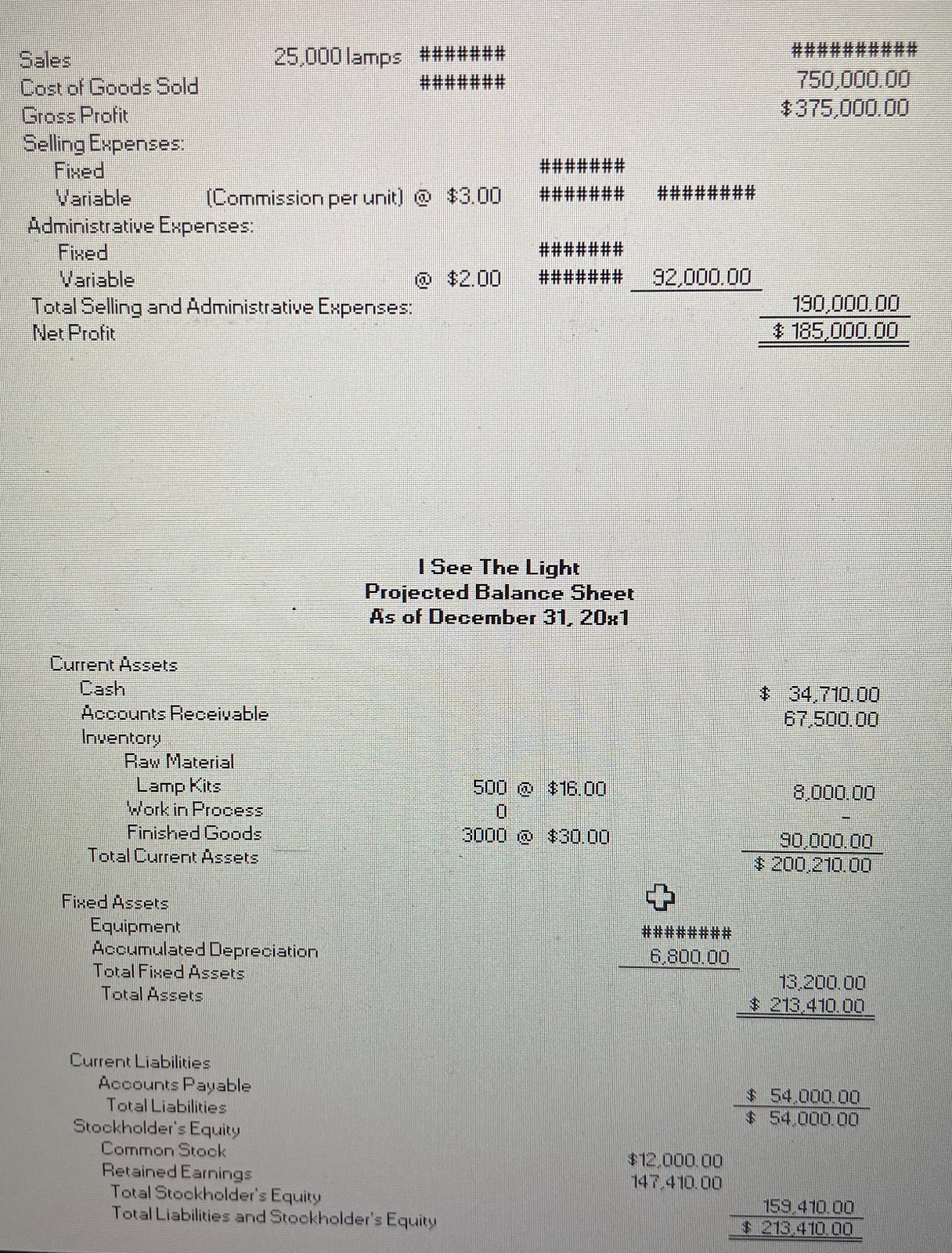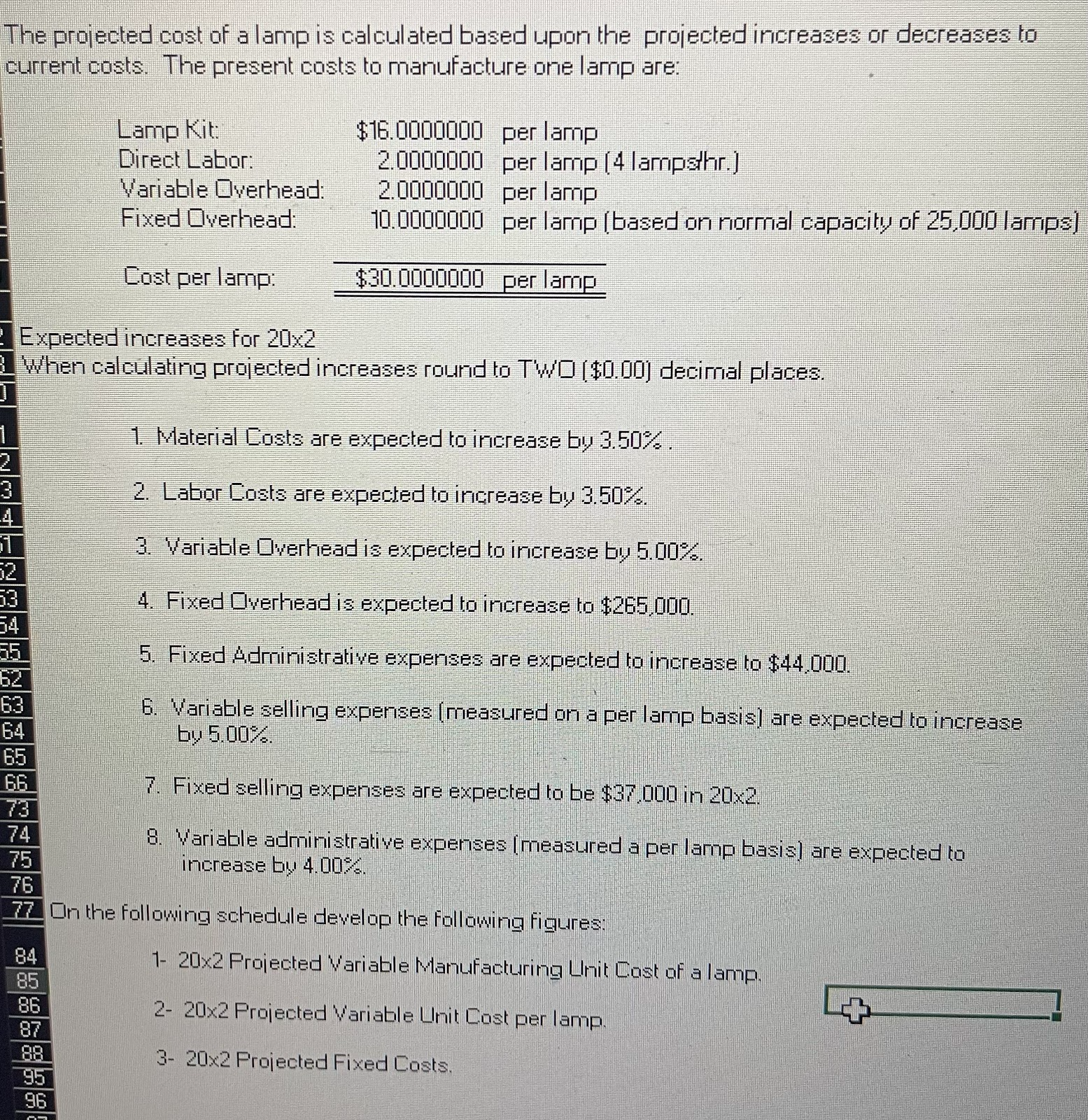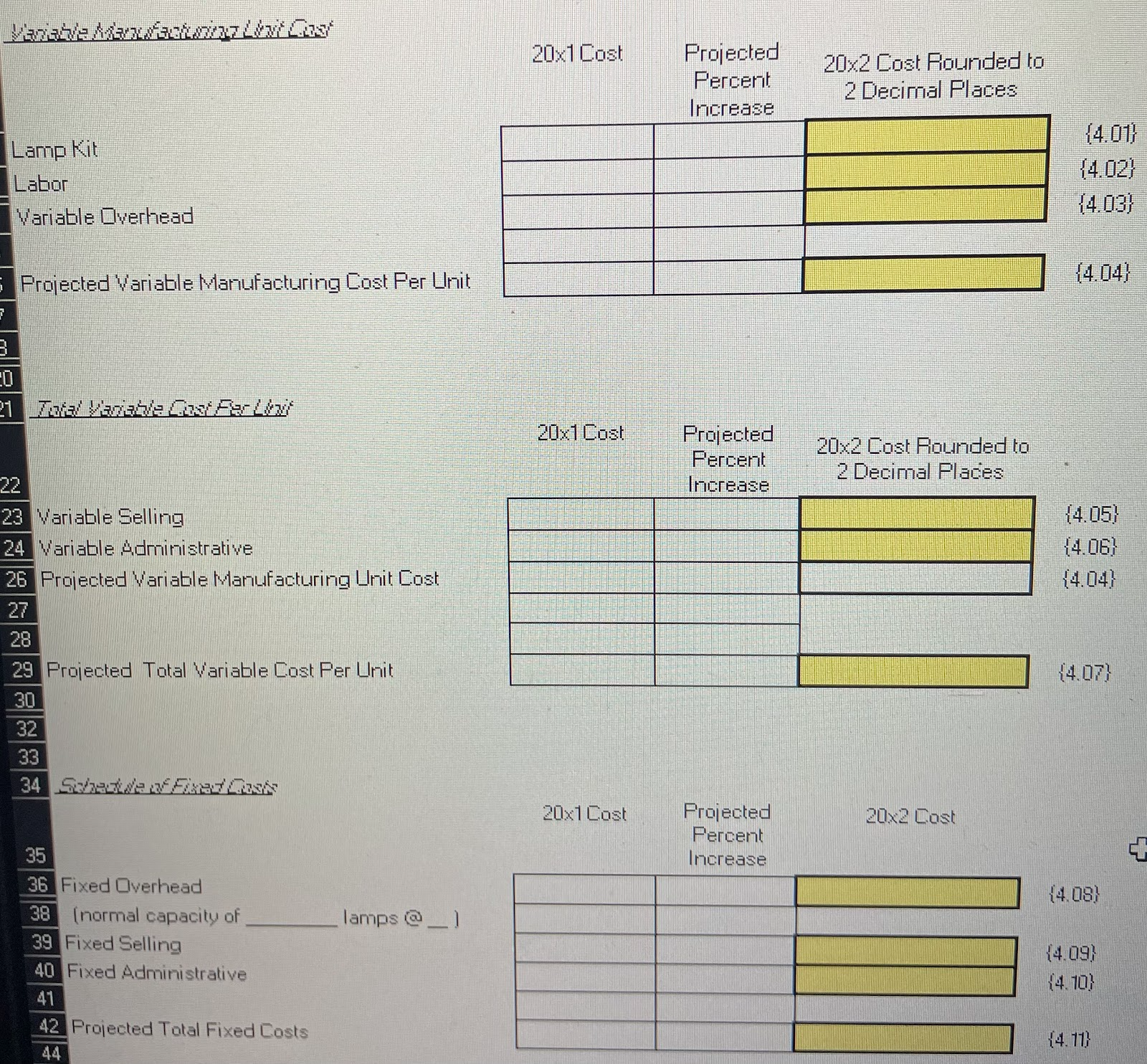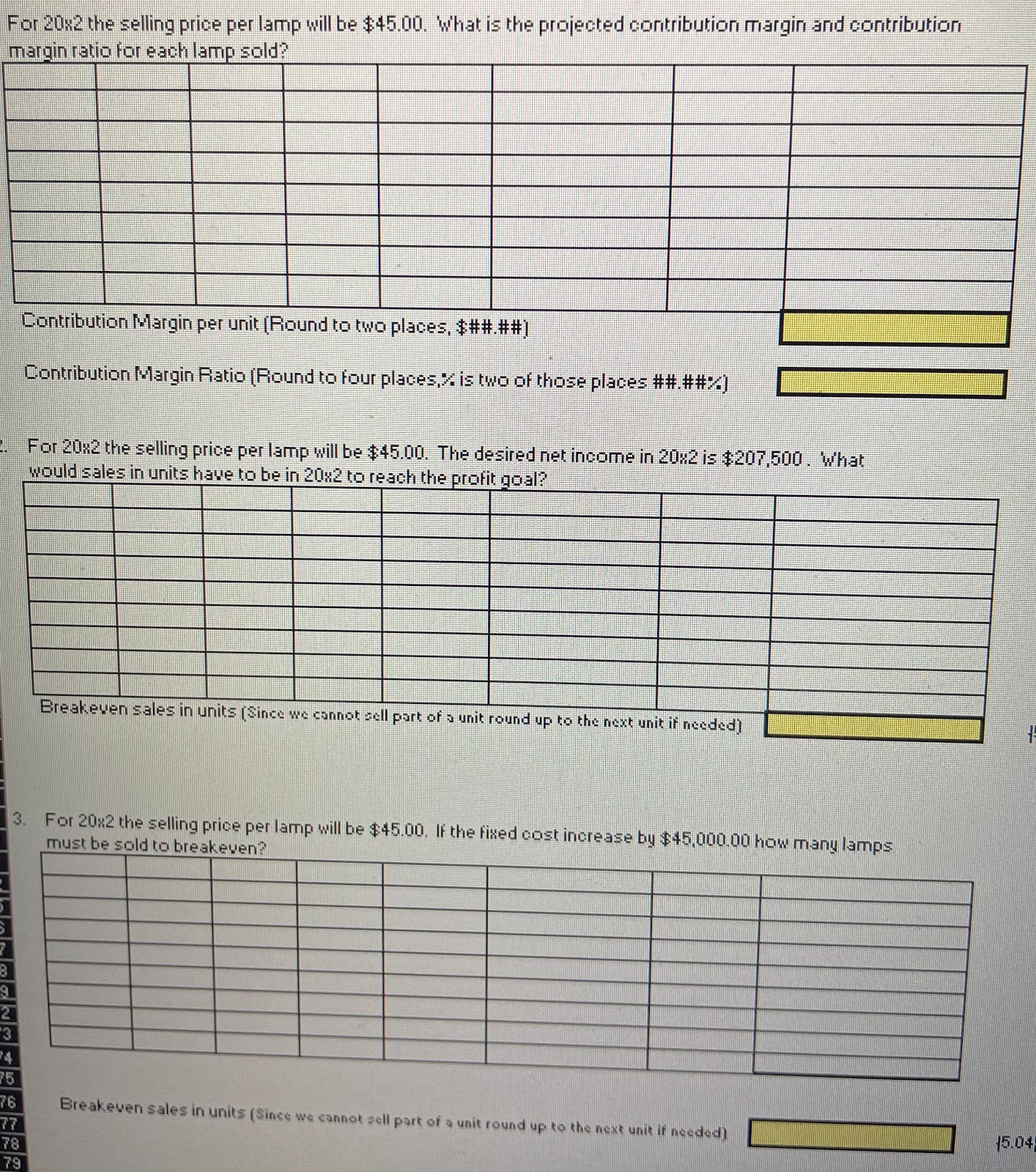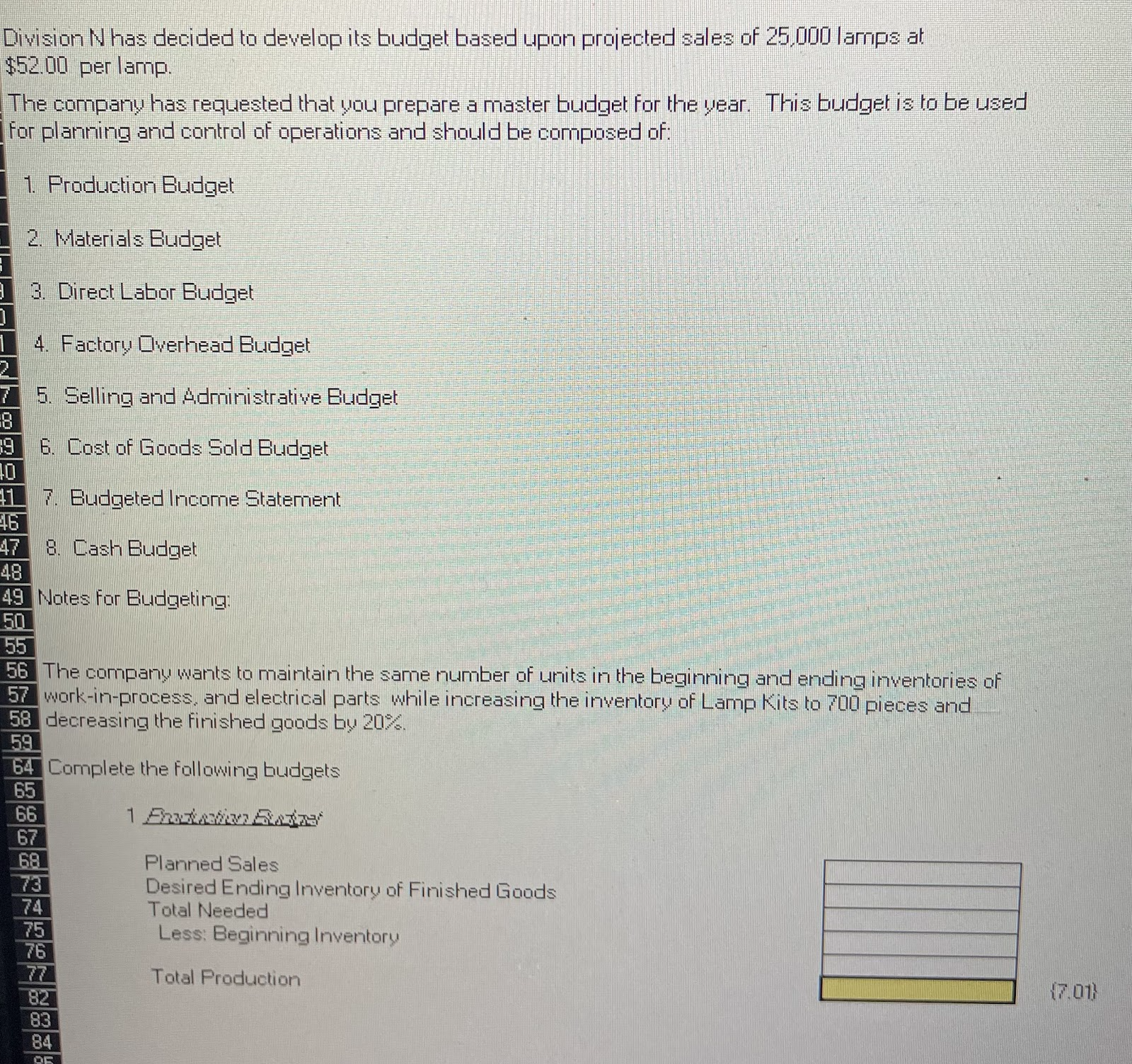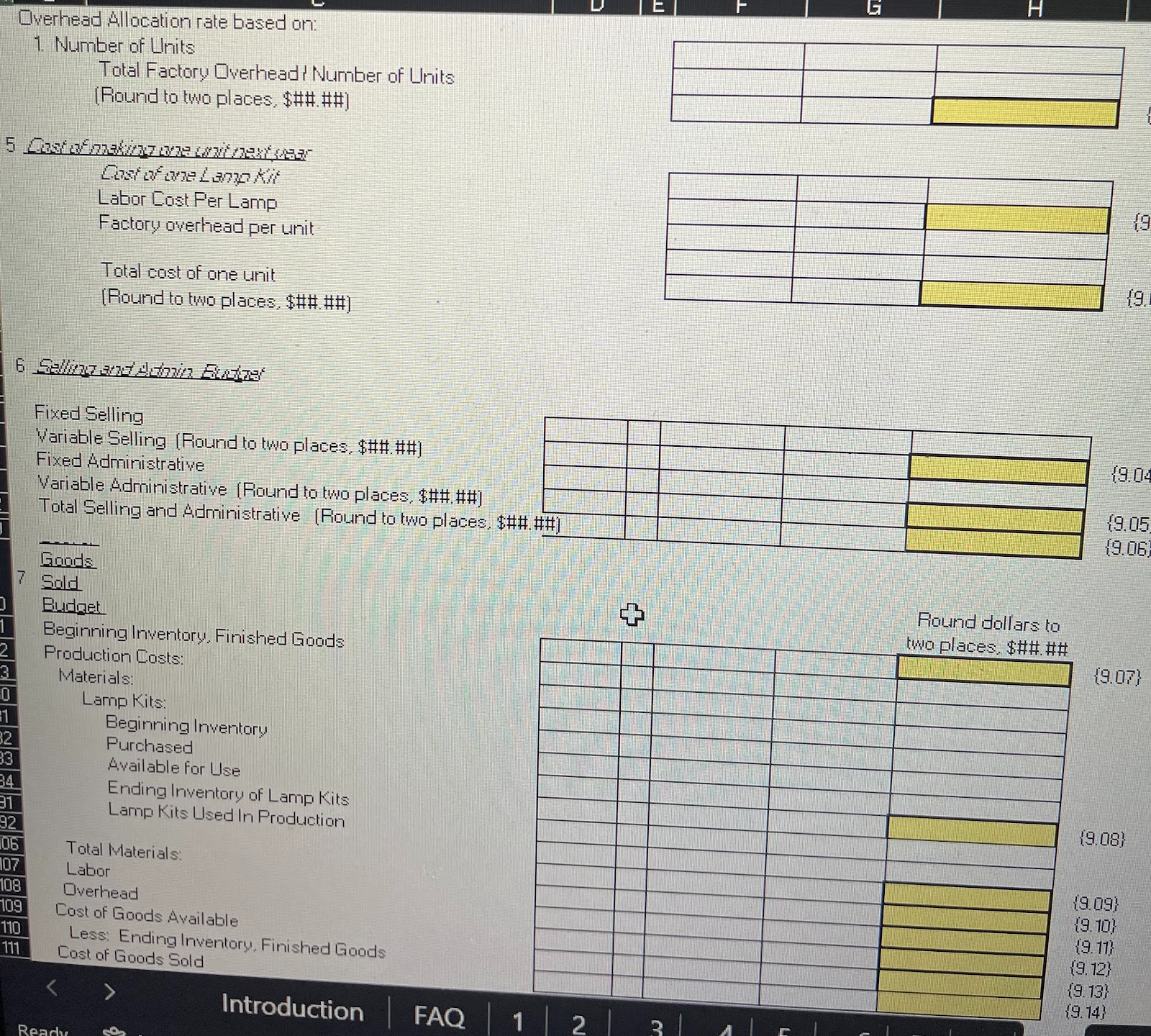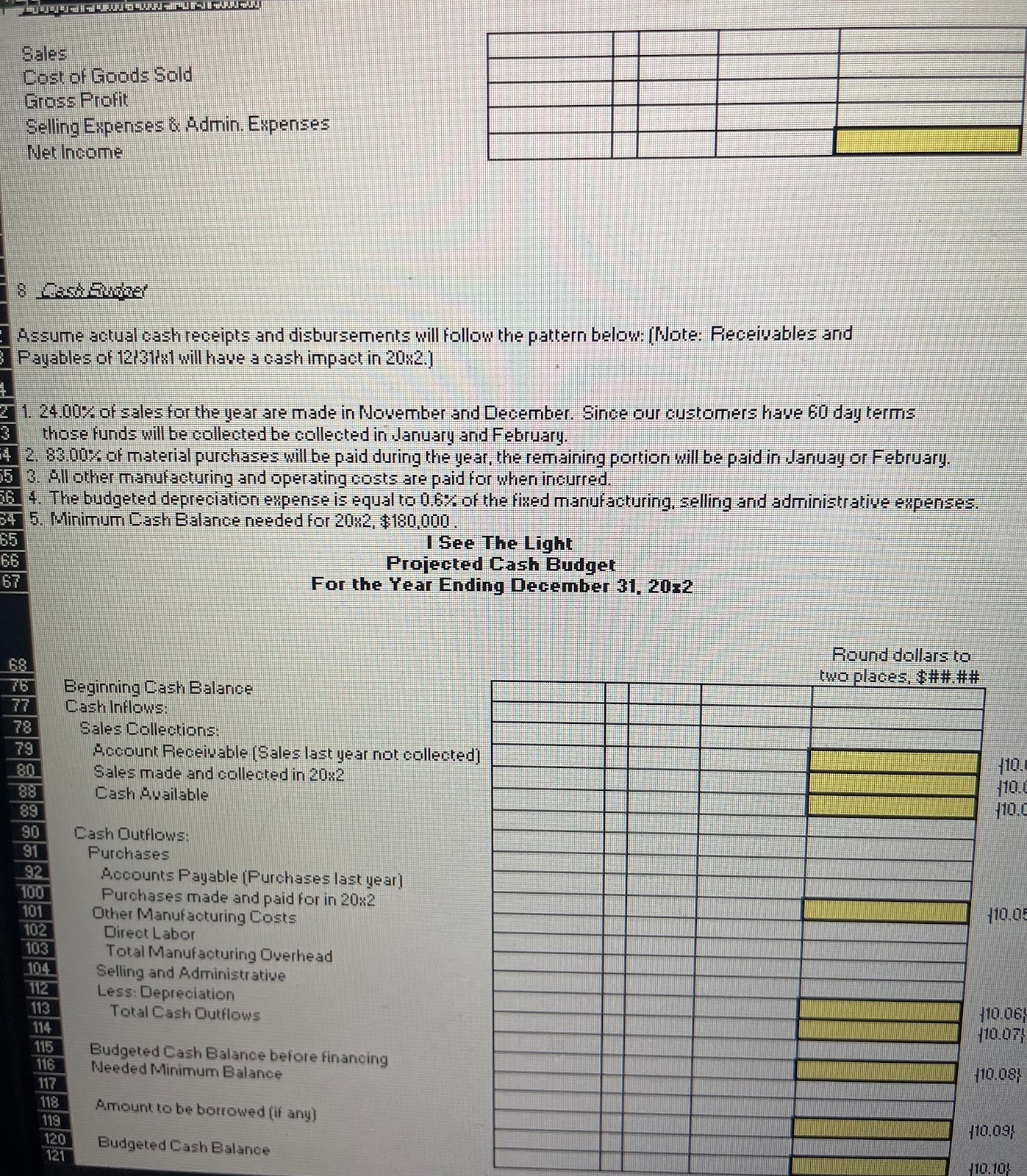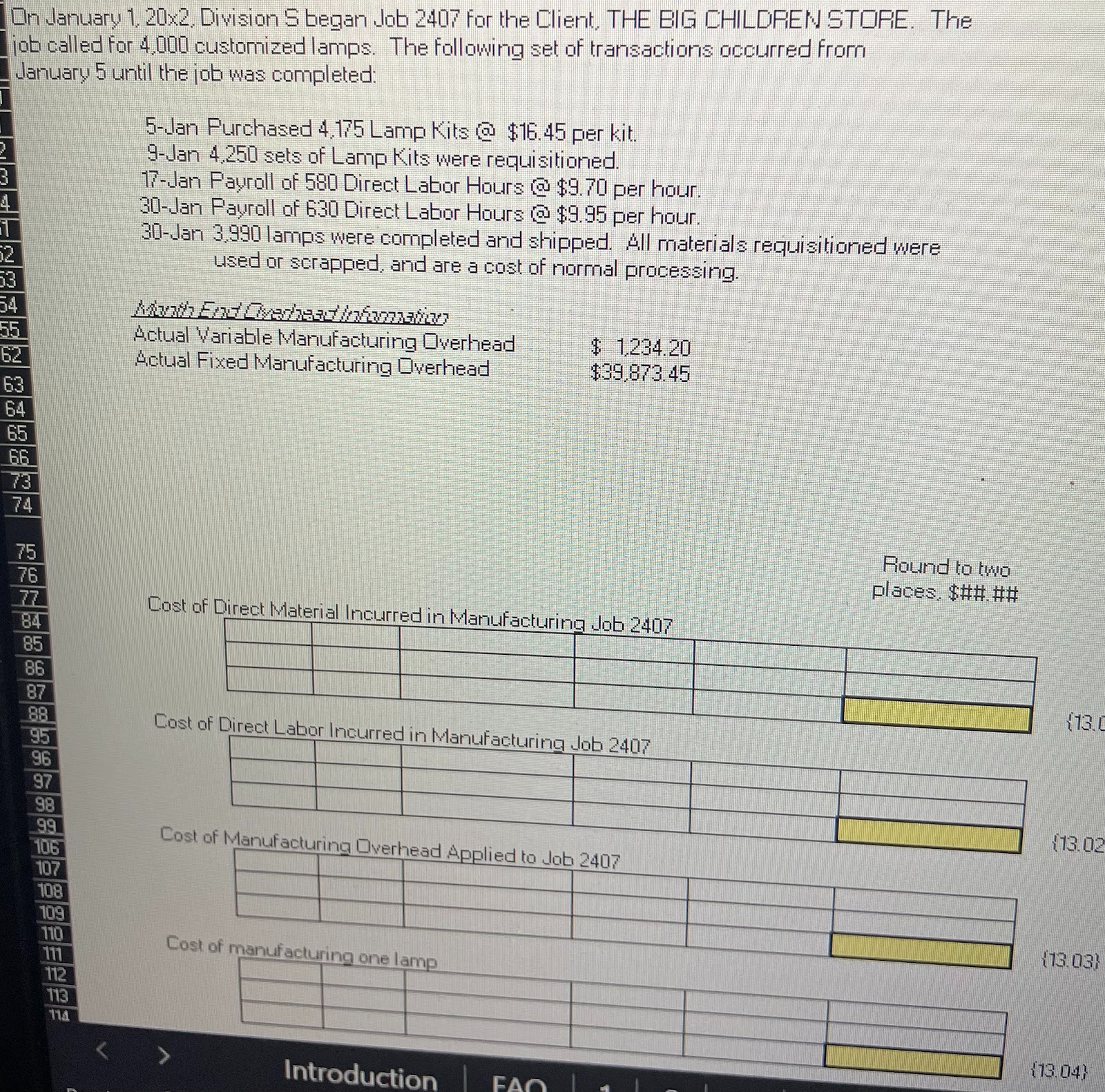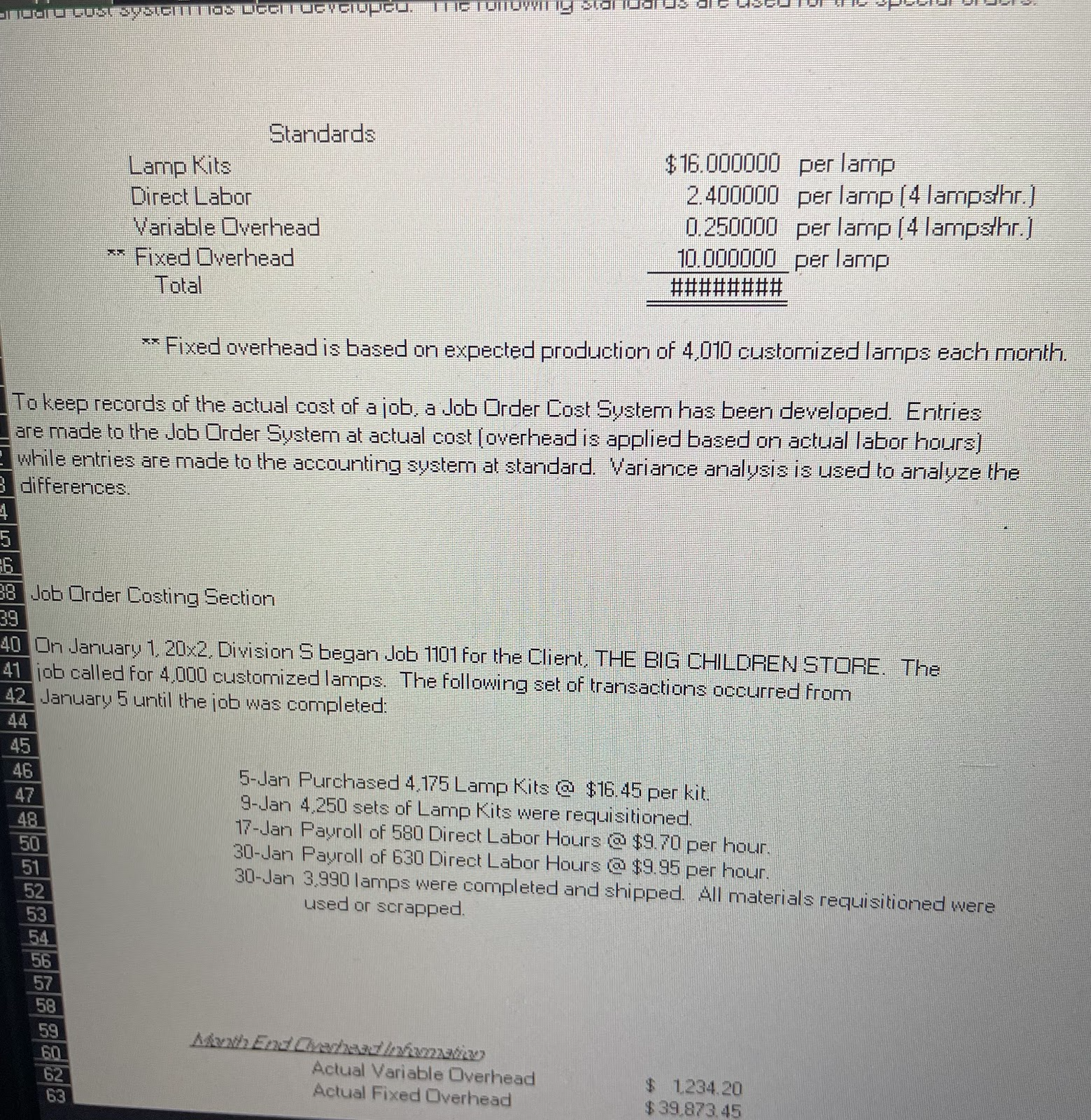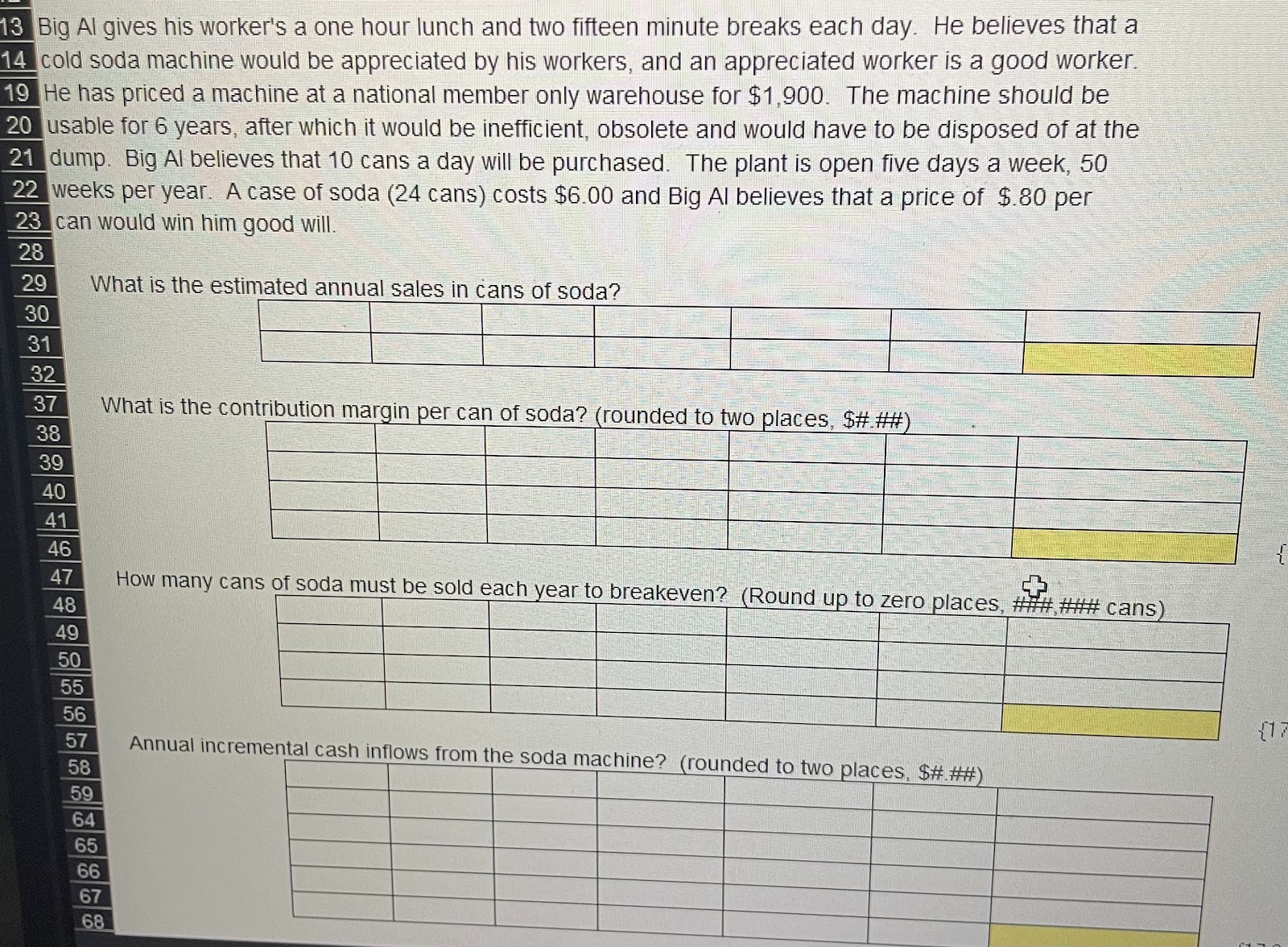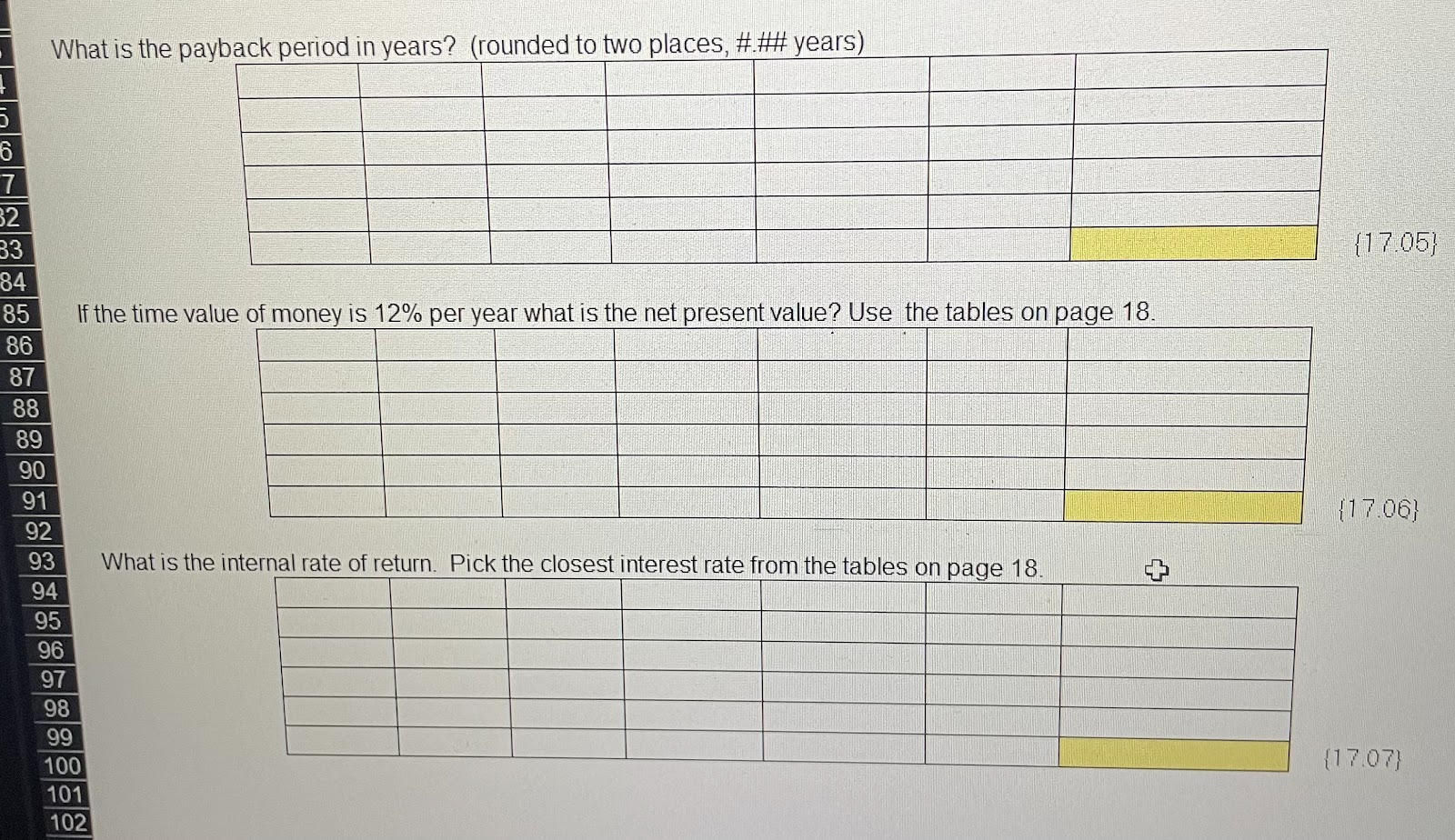Sales 25,000 lamps ####### ######HHHH Cost of Goods Sold # ###### 750,000.00 Gross Profit $375,000.00 Selling Expenses: Fixed # # # # # ## Variable (Commission per unit) @ $3.00 ####### ######## Administrative Expenses: Fixed ####### Variable @ $2.00 ####### 92,000.00 Total Selling and Administrative Expenses: 190,000.00 Net Profit $ 185,000.00 I See The Light Projected Balance Sheet As of December 31, 20x1 Current Assets Cash 34.710.00 Accounts Receivable 67,500.00 Inventory Raw Material Lamp Kits 500 @ $16.00 8,000.00 Work in Process 0 Finished Goods 3000 @ $30.00 00 000 08 Total Current Assets $ 200.210.00 Fixed Assets + Equipment # # # ##### Accumulated Depreciation 6,800.00 Total Fixed Assets 13.200.00 Total Assets $ 213.410.00 Current Liabilities Accounts Payable $ 54,000.00 Total Liabilities $ 54,000.00 Stockholder's Equity Common Stock $12,000,00 Retained Earnings 147.410.00 Total Stockholder's Equity 159.410.00 Total Liabilities and Stockholder's Equity $ 213.410.00The projected cost of a lamp is calculated based upon the projected increases or decreases to current costs. The present costs to manufacture one lamp are: Lamp Kit: $16.0000000 per lamp Direct Labor: 2.0000000 per lamp (4 lamps/hr.) Variable Overhead: 2.0000000 per lamp Fixed Overhead 10.0000000 per lamp (based on normal capacity of 25,000 lamps] Cost per lamp: $30.0000000 per lamp Expected increases for 20x2 When calculating projected increases round to TWO ($0.00) decimal places. 1. Material Costs are expected to increase by 3.50% 2. Labor Costs are expected to increase by 3.50%. 3. Variable Overhead is expected to increase by 5.00%%. 4. Fixed Overhead is expected to increase to $265,000. 5. Fixed Administrative expenses are expected to increase to $44,000. 53 6. Variable selling expenses ( measured on a per lamp basis] are expected to increase 64 by 5.00%. 65 7. Fixed selling expenses are expected to be $37 000 in 20x2. 73 74 8. Variable administrative expenses [ measured a per lamp basis) are expected to 75 increase by 4.002. 76 77 On the following schedule develop the following figures: 84 1- 20x2 Projected Variable Manufacturing Unit Cost of a lamp. 85 86 2- 20x2 Projected Variable Unit Cost per lamp. 87 88 3- 20x2 Projected Fixed Costs. 95 9620x1 Cost Projected 20x2 Cost Rounded to Percent 2 Decimal Places Increase Lamp Kit (4.01) Labor (4.02) Variable Overhead (4.03) Projected Variable Manufacturing Cost Per Unit (4.04) Trafal Mariahle Gas' Fer Loy 20x1 Cost Projected Percent 20x2 Cost Rounded to 22 Increase 2 Decimal Places 23 Variable Selling {4.05) 24 Variable Administrative (4.06) 26 Projected Variable Manufacturing Unit Cost (4.04} 27 28 29 Projected Total Variable Cost Per Unit {4.07} 30 32 33 20x1 Cost Projected 20x2 Cost Percent 35 Increase 36 Fixed Overhead (4. 08) 38 ( normal capacity of lamps (@_ 39 Fixed Selling 40 Fixed Administrative (4.09) 41 {4. 10 ) 42 Projected Total Fixed Costs 44 14. 11}For 2082 the selling price per lamp will be $45.00. What is the projected contribution margin and contribution margin ratio for each lamp sold? Contribution Margin per unit (Round to two places, $##.##] Contribution Margin Ratio (Round to four places,% is two of those places ##.##%) For 20:2 the selling price per lamp will be $45.00. The desired net income in 20:2 is $207,500. What would sales in units have to be in 20*2 to reach the profit goal? Breakeven sales in units (Since we cannot sell part of a unit round up to the next unit if needed) 3. For 20*2 the selling price per lamp will be $45.00. If the fixed cost increase by $45,000.00 how many lamps must be sold to breakeven? Breakeven sales in units (Since we cannot sell part of a unit round up to the next unit if needed) 5,04For 20*2 the selling price per lamp will be $45.00. If the variable cost increase by $4.50 a unit how many lamps must be sold to breakeven? Breakeven sales in units (Since we cannot sell part of a unit round up to the next unit if needed) 16. 5 For 20%2 the selling price per lamp will be $45.00. If the variable cost decreased by $4.50 a unit how many lamps must be sold to breakeven? Breakeven sales in units (Since we cannot sell part of a unit round up to the next unit if needed) 16.02 6. If For 20:2 the selling price per lamp is increased to $49.50 a unit how many lamps must be sold 48 to breakeven? 50 51 52 56 Breakeven sales in units (Since we cannot sell part of a unit round up to the next unit if needed) 16.03 65 66 7. If for 20*2 the selling price per lamp is decreased to $40.50 a unit how many lamps must be sold to breakeven? 68 73 74 Breakeven sales in units (Since we cannot sell part of a unit round up to the next unit if needed) 16.04,Division N has decided to develop its budget based upon projected sales of 25,000 lamps at $52.00 per lamp. The company has requested that you prepare a master budget for the year. This budget is to be used for planning and control of operations and should be composed of: 1. Production Budget 2. Materials Budget 3. Direct Labor Budget 4. Factory Overhead Budget 5. Selling and Administrative Budget 6. Cost of Goods Sold Budget 7. Budgeted Income Statement 17 8. Cash Budget 18 19 Notes For Budgeting: 50 56 The company wants to maintain the same number of units in the beginning and ending inventories of 57 work-in-process. and electrical parts while increasing the inventory of Lamp Kits to 700 pieces and 58 decreasing the finished goods by 20%. 59 64 Complete the following budgets 65 66 67 68 Planned Sales 73 Desired Ending Inventory of Finished Goods 74 Total Needed 75 Less: Beginning Inventory 76 Total Production (7.01) 2 8 82 Materials Budget Lamp Kits Needed for Production (8.01} Desired Ending Inventory (8.02) Total Needed (8.03) Less: Beginning Inventory (8.04) Total Purchases Cost per piece (8.05) Cost of Purchases (Round to two places, $##.##) (8.06) 3 Direct Labor Budget Labor Cost Per Lamp (8.07) Production Total Labor Cost (Round to two places, $##.##) (8.08) 4 Factory Overhead Budget Variable Factory Overhead: Variable Factory Overhead Cost Per Unit Number of Units to be Produced Total Variable Factory Overhead (Round to two places, $##.##) Fixed Factory Overhead (8.09) (8.10} Total Factory Overhead (Round to two places, $##.##) (8.11)Overhead Allocation rate based on. 1. Number of Units Total Factory Overhead / Number of Units [ Round to two places, $##.##) Post of ane Lamp Kit Labor Cost Per Lamp Factory overhead per unit Total cost of one unit 19 [ Round to two places, $##.##) 6 Selling and Admin Buddy Fixed Selling Variable Selling [Round to two places, $##.##) 9.0 Fixed Administrative Variable Administrative [Round to two places, $##.##) 19.05 Total Selling and Administrative (Round to two places, $##.##) 19.06 Goods Sold + `Round dollars to Budget two places. $##.## Beginning Inventory, Finished Goods (9.07) Production Costs: Materials: Lamp Kits: Beginning Inventory Purchased Available for Use Ending Inventory of Lamp Kits Lamp Kits Used In Production (9.08) Total Materials: Labor (9.09) Overhead 19. 10 } Cost of Goods Available {9. 11} 110 (9. 12) 111 Less: Ending Inventory. Finished Goods Cost of Goods Sold (9. 13) (9. 14) Introduction FAQ 1 2Sales Cost of Goods Sold Gross Profit Selling Expenses & Admin. Expenses Net Income 8 Cast Andbe Assume actual cash receipts and disbursements will follow the pattern below: (Note: Receivables and Payables of 12/31/x1 will have a cash impact in 20:2.] 1. 24.00% of sales for the year are made in November and December. Since our customers have 60 day terms those funds will be collected be collected in January and February. 2. 83.00% of material purchases will be paid during the year, the remaining portion will be paid in Januay or February. 3. All other manufacturing and operating costs are paid for when incurred. 6 4. The budgeted depreciation expense is equal to 0.6% of the fixed manufacturing, selling and administrative expenses 5. Minimum Cash Balance needed for 20:2, $180,000. I See The Light Projected Cash Budget 67 For the Year Ending December 31, 2012 Round dollars to two places, $##.## 75 Beginning Cash Balance Cash Inflows: 78 Sales Collections: Account Receivable (Sales last year not collected) 110 Sales made and collected in 20:2 110. Cash Available 10. Cash Outflows: 91 Purchases Accounts Payable [Purchases last year] 100 Purchases made and paid for in 20:2 Other Manufacturing Costs 410.05 102 Direct Labor 103 Total Manufacturing Overhead Selling and Administrative Less: Depreciation Total Cash Outflows (10.06 114 10.07; 115 Budgeted Cash Balance before financing Needed Minimum Balance Amount to be borrowed (if any) 119 10.09, 120 121 Budgeted Cash Balance 10.104On January 1. 20x2, Division S began Job 2407 for the Client, THE BIG CHILDREN STORE. The job called for 4.000 customized lamps. The following set of transactions occurred from January 5 until the job was completed: 5-Jan Purchased 4.175 Lamp Kits @ $16.45 per kit. 9-Jan 4.250 sets of Lamp Kits were requisitioned 17-Jan Payroll of 580 Direct Labor Hours @ $9.70 per hour. 30-Jan Payroll of 630 Direct Labor Hours @ $9.95 per hour. 30-Jan 3.930 lamps were completed and shipped. All materials requisitioned were used or scrapped, and are a cost of normal processing. Actual Variable Manufacturing Overhead $ 1.234.20 Actual Fixed Manufacturing Overhead $39,873.45 63 64 65 66 73 74 Round to two places. $##. ## Cost of Direct Material Incurred in Manufacturing Job 2407 (13. Cost of Direct Labor Incurred in Manufacturing Job 2407 (13.02 106 Cost of Manufacturing Overhead Applied to Job 2407 107 108 109 110 (13. 03) 111 Cost of manufacturing one lamp 112 113 114 (13. 04) IntroductionStandards $16.000000 per lamp Lamp Kits 2.400000 per lamp (4 lamps/hr. ] Direct Labor Variable Overhead 0.250000 per lamp (4 lamps/hr.) * Fixed Overhead 10.000000 per lamp Total # # # # # # # # * Fixed overhead is based on expected production of 4,010 customized lamps each month. To keep records of the actual cost of a job, a Job Order Cost System has been developed. Entries are made to the Job Order System at actual cost ( overhead is applied based on actual labor hours) while entries are made to the accounting system at standard. Variance analysis is used to analyze the differences Job Order Costing Section 40 On January 1. 20x2. Division S began Job 1101 for the Client. THE BIG CHILDREN STORE. The 41 job called for 4.000 customized lamps. The following set of transactions occurred from 42 January 5 until the job was completed: 44 45 46 5-Jan Purchased 4.175 Lamp Kits @ $16.45 per kit. 47 9-Jan 4.250 sets of Lamp Kits were requisitioned. 48 17-Jan Payroll of 580 Direct Labor Hours @ $9.70 per hour. 30-Jan Payroll of 630 Direct Labor Hours @ $9.95 per hour. 30-Jan 3.990 lamps were completed and shipped. All materials requisitioned were used or scrapped. Actual Variable Overhead $ 1.234.20 Actual Fixed Overhead $ 39.873.45How many Lamps were completed? Note: Show favorable variances as negative numbers Round dollars to two places. S## ## 3 6 What was the total material price variance for the Lamp Kits purchased? 7 8 19 20 What was the material usage variance for Lamp Kits? 23 24 25 26 27 30 31 What was the direct labor efficiency variance ? 32 (15.0 33 34 37 What was the direct labor rate variance? 38 (15.04 39 40 41 4413 Big Al gives his worker's a one hour lunch and two fifteen minute breaks each day. He believes that a 14 cold soda machine would be appreciated by his workers, and an appreciated worker is a good worker. He has priced a machine at a national member only warehouse for $1,900. The machine should be 20 usable for 6 years, after which it would be inefficient, obsolete and would have to be disposed of at the 21 dump. Big Al believes that 10 cans a day will be purchased. The plant is open five days a week, 50 22 weeks per year. A case of soda (24 cans) costs $6.00 and Big Al believes that a price of $.80 per 23 can would win him good will. 28 29 What is the estimated annual sales in cans of soda? 30 31 32 37 What is the contribution margin per can of soda? (rounded to two places, $# ##) 38 39 40 41 46 47 How many cans of soda must be sold each year to breakeven? (Round up to zero places, ###,### cans) 48 49 50 55 56 57 Annual incremental cash inflows from the soda machine? (rounded to two places, $#.##) 58 59 64 65 66 67 68What is the payback period in years? (rounded to two places, #.## years) 2 83 (17.05) 84 85 If the time value of money is 12% per year what is the net present value? Use the tables on page 18. 86 87 88 89 90 91 92 (17.06) 93 What is the internal rate of return. Pick the closest interest rate from the tables on page 18. 94 + 95 96 97 98 99 100 (17.07) 101 102
